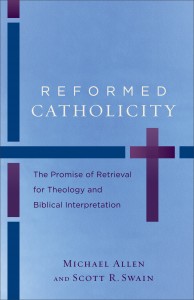 In Reformed Catholicity, Scott Swain and Michael Allen consider the backhanded monicker sometimes given to systematic theologians by biblical scholars/theologians: they’re just “proof-texters.” In other words, systematic theologians build their dogmatic structures on extrabiblical jargon and philosophical meanderings rather than on faithful exegesis of texts, only referencing a biblical text when it’s helpful to their case. (And let’s be honest, this is often a fair critique.)
In Reformed Catholicity, Scott Swain and Michael Allen consider the backhanded monicker sometimes given to systematic theologians by biblical scholars/theologians: they’re just “proof-texters.” In other words, systematic theologians build their dogmatic structures on extrabiblical jargon and philosophical meanderings rather than on faithful exegesis of texts, only referencing a biblical text when it’s helpful to their case. (And let’s be honest, this is often a fair critique.)
In a chapter called “In Defense of Proof Texting,” Swain and Allen consider how to employ proof-texting in a way that is biblically faithful, and how biblical scholars can be more optimistic about dogmatic discourse (pp. 137-141):
- “First, systematic theologians must be aware of the burden of proof upon them to show that they are using the Bible well in their theological construction. … More theologians should commit to an ongoing practice of doing exegetical work in their lectures, conference addresses, and their personal writing programs. … Any hope of making headway in these directions will reshape the reading program of systematic theologians.”
- “Second, biblical scholars should expect rigorous exegesis to lie behind such proof texting and should engage it conversationally and not cynically. When reading an exegetical excursus or even a parenthetical reference within a dogmatic text, assume that it represents an attempt at teasing out valid implications from a portion of Scripture read in proper literary and canonical perspective. Remember that dogmatics does not merely remain within the explicit categories, much less the idiom of the Bible.”
As a young wannabe theologian, I was as guilty as anyone of proof-texting my way through the systematic program of my choice. First, it was 5-point Arminianism, then came 5-point Calvinism. I would argue all day logically and philosophically, and when I went to the text, it was with such a heavy systematic presupposition that I’m not sure I even knew the context of the paragraph, much less the section or entire book.
The key transition for me was reading Daniel Treier’s little article, “Biblical theology and/or theological interpretation of scripture?,” followed by his book, Introducing Theological Interpretation of Scripture. While I’m rather sympathetic toward much that the theological interpretation of Scripture school has to offer, it wasn’t his actual conclusions that shook my systematic foundations–it was watching the process of a systematician wrestling with how to bring systematic and biblical theology together in a way that is faithful to Scripture.
While reading Treier and continuing to branch out into biblical theology, I realized that I’d been at best neglecting and at worst ignoring Scripture itself–its message and grand narrative in particular–in pursuit of winning theological slap-fights.
Swain and Allen are onto something here. They do a helpful job of avoiding the pitfalls of proof-texting and are sensitive to the genuine critiques of the practice. Systematic theologians can’t always avoid proof-texting, but that doesn’t mean they have to cherry-pick texts for their own systematic buffet. Biblical theologians, on the other hand, aren’t helpful when they assume that proof-texting (or what appears to be proof-texting) is trite and ignorant, but they certainly have been given legitimate reason for concern.
Some joke that Gabler’s bifurcation is to blame for this hubbub, and perhaps in some ways he is. His speech, “On the Correct Distinction Between Dogmatic and Biblical Theology and the Right Definition of Their Goals,” is considered by some as an atom bomb to academia. But I don’t have a problem with separate theological disciplines in order to create experts or nuance, so long as we recognize that we need each other, that we can learn from one another, and that we can’t be myopic and narrow in our studies.
As Swain and Allen conclude, biblical scholars/theologians and systematic theologians serve two different, complementary purposes, and the disciplines have been melded together throughout church history. So let’s mix in a hug every once in awhile.












